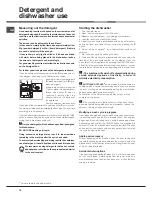
11
GB
Wash cycles
Wash-cycle data is measured under laboratory conditions according to European Standard EN 50242.
Based on the different conditions of use, the wash-cycle duration and data can change.
The number and type of wash cycles and options may vary depending on the dishwasher model.
Wash cycle
Wash cycle
which
include
drying
Options
Approximate
duration of wash
cycles
h:min.
Water
consumption
(l/cycle)
Energy
consumption
(KWh/cycle)
1. Eco
Yes
Delayed start –
Half Load - Tabs
03:00
9,0
0,83
2. Auto Intensive
Yes
Delayed start –
Half Load - Tabs
02:20 - 03:00
13,0 - 14,0
1,20 - 1,40
3. Auto Normal
Yes
Delayed start –
Half Load - Tabs
01:40 - 02:20
13,5 – 14,5
1,00 - 1,15
4. Delicates
Yes
Delayed start –
Half Load - Tabs
01:40
9,0
0,85
5. Express
No
Delayed start – Tabs
00:25
8,0
0,45
6. Good Night
Yes
Delayed start – Tabs
03:30
13,0
0,85
7. Soak
No
Delayed start –
Half Load
00:10
4,0
0,01
8. Short Time
Yes
Delayed start – Tabs
01:20
15,5
1,10
9. Ultra Intensive
Yes
Delayed start –
Half Load - Tabs
02:50
17,0
1,45
Instructions on wash-cycle selection and detergent dosage
1.
The ECO wash cycle is the standard cycle to which the energy label data refers. It can be used to wash crockery with a normal
soil level and is the most efficient cycle in terms of energy and water consumption for this type of crockery.
4 gr/ml**+ 21 gr/ml – 1 Tab
(**Quantity of pre-washing detergent)
2.
Heavily soiled dishes and pans (not to be used for delicate items). 25 gr/ml – 1 Tab
3.
Normally soiled pans and dishes. 4 gr/ml**+ 21 gr/ml – 1 Tab
4.
Cycle for delicate items, which are more sensitive to high temperatures 25 gr/ml – 1 Tab
5.
Fast cycle to be used for slightly dirty dishes (ideal for 2 place settings) 21 gr/ml – 1 Tab
6.
Optimum performance ensured. Ideal for night-time operation. 25 gr/ml – 1 Tab
7.
Pre-wash while awaiting completion of the load with the dishes from the next meal. No detergent.
8.
Quick wash and dry cycle, suitable for crockery and pans with a normal soil level.
25 gr/ml – 1 Tab
9.
Heavily soiled saucepans or pans with residual dried-on food. 4 gr/ml**+ 25 gr/ml – 1+1 Tab
Standby consumption: Left-on mode consumption: 5 W - Off mode consumption: 0.5 W.


































